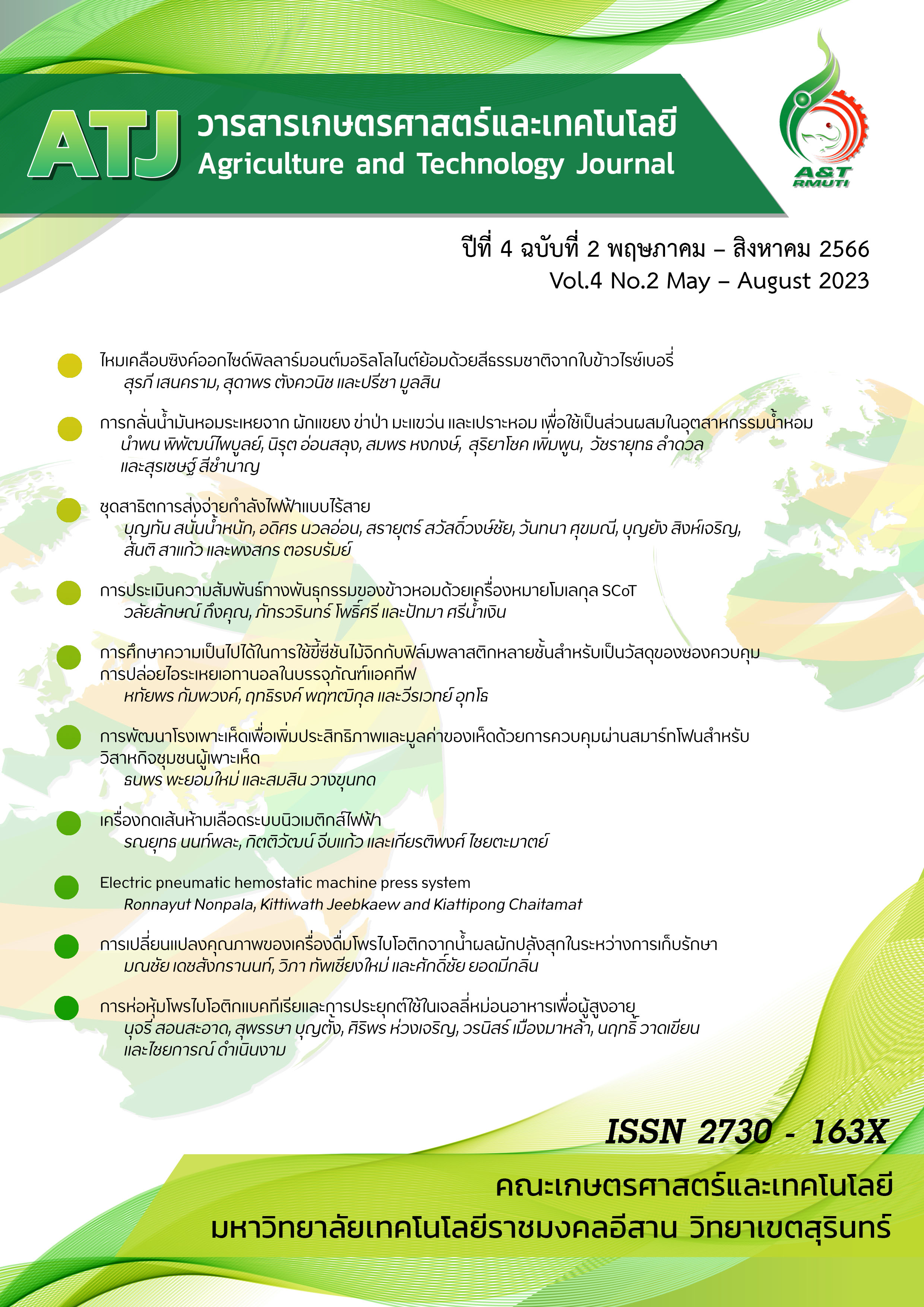การศึกษาความเป็นไปได้ในการใช้ขี้ซีชันไม้จิกกับฟิล์มพลาสติกหลายชั้นสำหรับเป็นวัสดุของซองควบคุม การปล่อยไอระเหยเอทานอลในบรรจุภัณฑ์แอคทีฟ
คำสำคัญ:
ซองควบคุมการปล่อยไอระเหยเอทานอล, ขี้ซีชันไม้จิก, บรรจุภัณฑ์แอคทีฟ, ฟิล์มพลาสติกหลายชั้นบทคัดย่อ
การวิจัยนี้มีวัตถุประสงค์เพื่อศึกษาความเป็นไปได้ของการใช้ขี้ซีชันไม้จิก (วัสดุ KC) กับฟิล์มพลาสติกหลายชั้นสำหรับเป็นวัสดุของซองควบคุมการปล่อยไอระเหยเอทานอลในบรรจุภัณฑ์แอคทีฟ การวิจัยนี้พัฒนาฟิล์มพลาสติกหลายชั้นต้นแบบ
โดยการทาสารละลายขี้ซีชันไม้จิกลงบนผิวหน้าของฟิล์ม Ethylene vinyl acetate (EVA) จากนั้นเชื่อมประกบฟิล์มพลาสติก Low density polyethylene (LDPE) ทั้งสองด้านโดยเทคนิคการปิดผนึกด้วยความร้อน ต้นแบบฟิล์มแอคทีฟ KC (LDPE/KC/EVA/LDPE) ได้นำไปพัฒนาเป็นซองควบคุมฯ (KC sachet) ซึ่งมีผนังเป็นฟิล์มอะลูมิเนียมลามิเนตและฟิล์มแอคทีฟ KC โดยมีกระดาษกรองที่เอิบชุ่มด้วยเอทานอลเหลวอยู่ภายในซองควบคุมฯ การวิจัยได้ศึกษาการปลดปล่อยไอระเหย
เอทานอลจากซองควบคุมฯ (KC sachet) ในบรรจุภัณฑ์อะลูมิเนียมลามิเนตปริมาตร 250 ml ความเข้มข้นไอระเหยเอทานอลในบรรจุภัณฑ์ได้รับการวิเคราะห์ด้วยเครื่อง Flame-ionized detector gas chromatogram (FID-GC) ในระหว่างการเก็บรักษา 17 วัน ที่อุณหภูมิ 25°C และเปรียบเทียบกับความเข้มข้นของไอระเหยเอทานอลซึ่งปลดปล่อยจากซองควบคุมฯ ทำจากฟิล์ม LDPE (LDPE sachet) และฟิล์มหลายชั้นที่ไม่มีวัสดุ KC (2LDEVA sachet) ผลการทดลองแสดงให้ทราบว่าความเข้มข้นของไอระเหยเอทานอลในทุกสิ่งทดลองเพิ่มขึ้นอย่างรวดเร็วและต่อเนื่องในช่วง 7 วันแรก จากนั้นการเปลี่ยนแปลงความเข้มข้นเกิดขึ้นช้าลงและมีแนวโน้มคงที่ ความเข้มข้นไอระเหยเอทานอลสูงสุดพบในสิ่งทดลอง KC sachet ในขณะที่ค่าต่ำสุดพบในสิ่งทดลอง 2LDEVA sachet แบบจำลองคณิตศาสตร์ประเภท First-order kinetic reaction สามารถทำนายการระดับและการเปลี่ยนแปลงความเข้มข้นของไอระเหยเอทานอลได้ดี (R2 เท่ากับ 0.99) อัตราเร็วที่สูงของการเปลี่ยนแปลงความเข้มข้นฯ ในสิ่งทดลอง KC sachet ได้ตั้งสมมติฐานว่าอาจเกิดจากปรากฏการณ์พลาสติไซเซชันในโครงสร้างของฟิล์มพลาสติกโดยมีสาเหตุจากทั้งโมเลกุลเอทานอลและสารประกอบอินทรีย์ของขี้ซีชันไม้จิกที่เกิดการซึมผ่านภายในชั้นฟิล์มอย่างต่อเนื่อง นอกจากนี้
ไอระเหยของขี้ซีชันไม้จิกได้ถูกปลดปล่อยออกมาร่วมกับไอระเหยเอทานอลโดยประเภทของไอระเหยดังกล่าวอยู่ในระหว่างการพิสูจน์ทราบเพื่อการพัฒนาซองควบคุมฯ KC ต่อไป
เอกสารอ้างอิง
พัชรี มะลิลา. (2563). การพัฒนาฟิล์มพลาสติกที่สำหรับควบคุมการปล่อยไอระเหยเอทานอลด้วยการกระตุ้นโดยแก๊สคาร์บอนไดออกไซด์ในการบรรจุแอคทีฟสำหรับผักและผลไม้ตัดสด. วิทยานิพนธ์ปริญญาปรัชญาดุษฏีบัณฑิต สาขาเทคโนโลยีการอาหาร คณะเกษตรศาสตร์ มหาวิทยาลัยอุบลราชธานี.
วีรเวทย์ อุทโธ, เอกสิทธิ์ อ่อนสะอาด และเรวัติ ชัยราช. (2555). การพัฒนาซองควบคุมการปล่อยไอระเหยเอทานอลสำหรับมะละกอสุกตัดสด. วารสารเกษตรพระจอมเกล้า. 30(2): 39-49.
วีรเวทย์ อุทโธ. (2562). การบรรจุภัณฑ์บรรยากาศดัดแปรแอคทีฟสำหรับผักและผลไม้. โรงพิมพ์มหาวิทยาลัยอุบลราชธานี, อุบลราชธานี.
หทัยพร กัมพวงค์. (2563). การพัฒนาซองควบคุมการปล่อยไอระเหยเอทานอลด้วยการกระตุ้นโดยความชื้นเพื่อการบรรจุภัณฑ์แอคทีฟสำหรับพริกหวานสด. วิทยานิพนธ์ปริญญาวิทยาศาสตรมหาบัณฑิต สาขาเทคโนโลยีการอาหาร คณะเกษตรศาสตร์ มหาวิทยาลัยอุบลราชธานี.
Ahmed J., Mulla M., Jacob H., Luciano G., T.b. and Almusallam A. (2019). Polylactide/poly (ε-caprolactone)/zinc oxide/clove essential oil composite antimicrobial films for scrambled egg packaging. Food Packaging and Shelf Life. 21(3): 45-55.
Avila I.M.L.B. and Silva C.L.M. (1999). Modelling kinetics of thermal degradation of colour in peach puree. Journal of Food Engineering. 39(2): 161-166.
Dong Z., Xu F., Ahmed I., Li Z. and Lin H. (2018). Characterization and preservation performance of active polyethylene films containing rosemary and cinnamon essential oils for Pacific white shrimp packaging. Food Control. 92(1): 37-46.
Earle M.D. and Earle R.L. (2003). Fundamentals of food reaction technology. Royal society of chemistry: NY.
Gui H., Zhao M., Zhang S., Yin R., Hu C., Fan M. and Li L. (2022). Active antioxidant packaging from essential oils incorporated polylactic acid/ poly (butylene adipate-co-terephthalate)/thermoplastic starch for preserving straw mushroom. Foods. 11(15): 1-15.
Han Lyn F. and Nur Hanani Z.A. (2020). Effect of lemongrass (Cymbopogon citratus) essential oil on the properties of chitosan films for active packaging. Journal of Packaging Technology and Research. 4(1): 33-44.
Johansson F. and Leufven A. (1994). Food packaging polymer films as aroma vapor barriers at different relative humidities. Journal of Food Science. 59(6): 1328-1331.
Kampawong H., Utto W. and Pruthtikul R. (2021). Effects of relative humidity on ethanol vapour releases from hydrophilic film-based sachet in active food packaging. Food Research. 5(5): 89-94.
Khorram F. and Ramezanian A. (2021). Cinnamon essential oil incorporated in shellac, a novel bio-product to maintain quality of ‘Thomson navel’ orange fruit. Journal of Food Science and Technology. 58(8): 2963-2972.
Mahizan N.A., Yang S.K., Moo C.L., Song A.A.L., Chong C.M., Chong C.W., Abushelaibi A., Lim S.H. E. and Lai K.S. (2019). Terpene derivatives as a potential agent against antimicrobial resistance (amr) pathogens. Molecules. 24(14): 1-21.
Masyita A., Mustika Sari R., Dwi Astuti A., Yasir B., Rahma Rumata N., Emran T. B., Nainu F. and Simal-Gandara J. (2022). Terpenes and terpenoids as main bioactive compounds of essential oils, their roles in human health and potential application as natural food preservatives. Food Chemistry: X. 13(1): 8-17.
Miyauchi M., Nakanishi Y. and Sagara Y. (1996). Permeation of water and volatile flavors through packaging films. Food Science and Technology International, Tokyo. 2(4): 217-222.
Morkhade D.M. (2017) Evaluation of gum mastic (Pistacia lentiscus) as a microencapsulating and matrix forming material for sustained drug release. Asian Journal of Pharmaceutical Sciences. 12(5): 424-432.
Phromnoi K., Sinchaiyakij P., Khanaree C., Nuntaboon P., Chanwikrai Y., Chaiwangsri T. and Suttajit M. (2019). Anti-inflammatory and antioxidant activities of medicinal plants used by traditional healers for antiulcer treatment. Scientia Pharmaceutica. 87(3): 1-12.
Phungam, N., Utto, W. and Pruthtikul, R. (2018). Interaction between surface coating using cabbage leaf wax extract and temperature on water vapour and gas exchange properties of fresh okra (Abelmoschus esculentus (L.) Moench). International Food Research Journal. 25(5): 1885-1892.
Ramle S.F.M., Kawamura F., Sulaiman O., Hashim R. and Ohara S. (2010). Antifungal properties and radical scavenging activities of Dipterocarpaceae family from selected malaysian timbers. Environmental Research and Technology. 5(2): 70-74.
Robertson G.L. (2012). Food packaging: Principles and Practice. 2nd Edition. Taylor and Francis Group: NY.
Sharma S., Barkauskaite S., Jaiswal A.K. and Jaiswal S. (2021). Essential oils as additives in active food packaging. Food Chemistry. 343(2): 128-133.
Sireeratawong S., Khonsung P., Nanna U., Vannasiri S., Lertprasertsuke N., Singhalak T., Soonthornchareonnon N. and Jaijoy K. (2012). Anti-diarrheal activity and toxicity of learng pid samud recipe. African Journal of Traditional. Complementary and Alternative Medicines. 9(4): 519-529.
Thongsrikhem N., Taokaew S., Sriariyanun M. and Kirdponpattara S. (2022). Antibacterial activity in gelatin-bacterial cellulose composite film by thermally crosslinking with cinnamaldehyde towards food packaging application. Food Packaging and Shelf Life. 31(1): 58-66.
Utto W. (2014). Factors affecting release of ethanol vapour in active modified atmosphere packaging systems for horticultural products. Maejo International Journal of Science and Technology. 8(2): 75-85.
Utto W., Pruthtikul R., Malila P., Noomhorm A. and Bronlund J.E. (2016). Concentration and temperature dependences of effective ethanol vapor permeance of plastic films utilized in controlled release-based active packaging for horticultural products. Key Engineering Materials. 718(1): 45-48.
Utto W., Preutikul R., Malila P., Noomhorm A. and Bronlund J.E. (2018). Delaying microbial proliferation in fresh peeled shallots by active packaging incorporating ethanol vapour controlled release sachets and low storage temperature. Food Science and Technology International. 24(1): 132-144.
ดาวน์โหลด
เผยแพร่แล้ว
เวอร์ชัน
- 19-02-2024 (2)
- 30-08-2023 (1)
รูปแบบการอ้างอิง
ฉบับ
ประเภทบทความ
สัญญาอนุญาต
ลิขสิทธิ์ (c) 2023 วารสารเกษตรศาสตร์และเทคโนโลยี

อนุญาตภายใต้เงื่อนไข Creative Commons Attribution-NonCommercial-NoDerivatives 4.0 International License.
เนื้อหาและข้อมูลในบทความที่ลงตีพิมพ์ในวารสารทดสอบระบบ ThaiJo2 ถือเป็นข้อคิดเห็นและความรับผิดชอบของผู้เขียนบทความโดยตรงซึ่งกองบรรณาธิการวารสาร ไม่จำเป็นต้องเห็นด้วย หรือร่วมรับผิดชอบใดๆ
บทความ ข้อมูล เนื่อหา รูปภาพ ฯลฯ ที่ได้รับการดีพิมพ์ในวารสารทดสอบระบบ ThaiJo2 ถือเป็นลิขสิทธิ์ของวารสารทดสอบระบบ ThaiJo2 หากบุคคลหรือหน่วยงานใดต้องการนำทั้งหมดหรือส่วนหนึ่งส่วนใดไปเผยแพร่หรือเพื่อกระทำการใดๆ จะต้องได้รับอนุญาตเป็นลายลักอักษรณ์จากวารสารทดสอบระบบ ThaiJo2 ก่อนเท่านั้น







